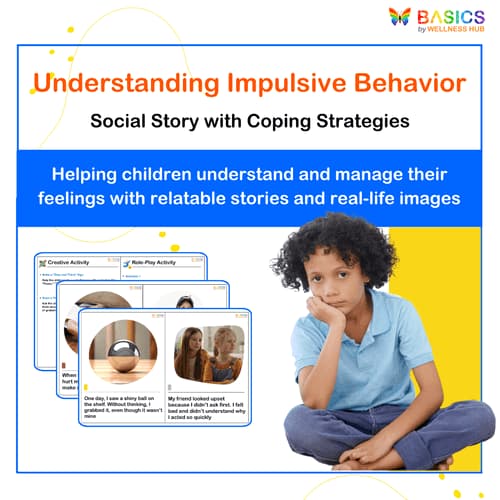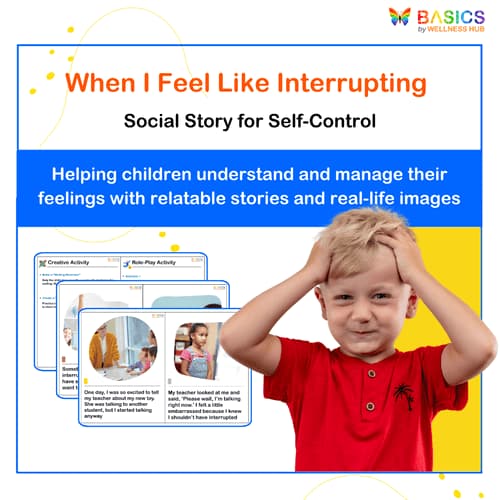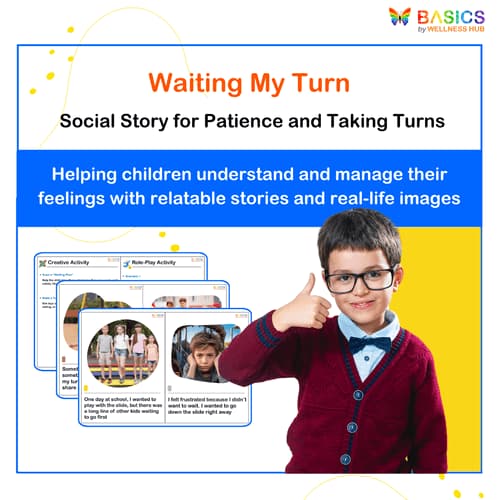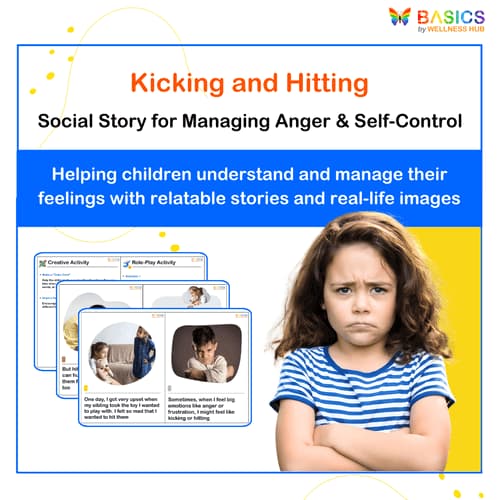





Hot and Cold Flashcards: Learn Temperature Concepts with Objects
₹80
₹160
50% off
0 (0 ratings)
Grade Levels
Pre-K - Grade 1 (Ages 3-6)
Content Overview
Format: PDF, Total Pages: 6, Features: 24 pairs of hot and cold objects with high-quality illustrations.
Categories
Pages from the Resource
Teach temperature concepts with our "Hot and Cold Flashcards: Learn Temperature Concepts with Objects." This resource includes 24 pairs like "hot tea, cold ice cream" and "hot cocoa, cold lemonade," helping kids ages 3-6 understand the differences between hot and cold objects.

Page 1

Page 2
What Users Say
0
0 ratings
5
0+
4
0+
3
0+
2
0+
1
0+
5 Stars
Product is Good to use.
10 months ago
Varsha Parent
Similar Products

Understanding Impulsive Behavior: Social Story with Coping Strategies
₹ 80.00
₹ 160.00
50% off
4.9 (42 ratings)

When I Feel Like Interrupting – Social Story for Self-Control
₹ 80.00
₹ 160.00
50% off
4.8 (60 ratings)

Waiting My Turn – Social Story for Patience and Taking Turns
₹ 80.00
₹ 160.00
50% off
4.7 (56 ratings)

Kicking and Hitting – Social Story for Managing Anger & Self-Control
₹ 80.00
₹ 160.00
50% off
4.6 (52 ratings)

Understanding Swear Words – Social Story for Respectful Communication
₹ 80.00
₹ 160.00
50% off
4.9 (48 ratings)
About the Product
Purpose of the Flashcards: The "Hot and Cold Flashcards: Learn Temperature Concepts with Objects" resource is designed to introduce young learners to the foundational concept of temperature by helping them distinguish between hot and cold objects. Understanding the differences between hot and cold is an essential early learning concept that supports sensory development, cognitive growth, and pre-math skills. These flashcards make learning engaging and interactive, allowing children to grasp the concept of temperature through familiar and everyday objects.
Target Audience: This resource is ideal for parents, early childhood educators, and special education professionals looking to engage children ages 3-6 in activities that teach the concept of temperature using relatable, real-world objects. The flashcards can be used in both one-on-one instruction and group settings, making them versatile for various educational environments.
Product Details
Content Description: The set includes 24 pairs of objects, each featuring one hot and one cold item. The flashcards are organized into a 6-page high-quality PDF, with four pairs of objects on each page. Examples include "hot cocoa, cold lemonade," "hot tea, cold ice cream," and "hot soup, cold soda." Each pair is carefully illustrated with clear, high-resolution images, and both the object and its temperature descriptor are labeled for easy identification.
Image Quality and Design: The flashcards are designed with vibrant, high-resolution illustrations that are visually appealing and easy for young children to understand. The layout is clean and simple, ensuring that children can focus on the key concept of temperature comparison without distractions.
Educational Benefits
Temperature Concept Learning: These flashcards provide an introduction to understanding temperature differences by comparing hot and cold objects. Children learn to identify and describe the characteristics of objects based on their temperature, which is a fundamental early science concept.
Cognitive Development: Associating objects with temperature helps children develop cognitive skills such as categorization, comparison, and observation. The process of identifying whether an object is hot or cold reinforces critical thinking and decision-making abilities.
Sensory Learning: Learning about temperature through visual representation of objects helps children connect the concept of hot and cold with their real-world experiences, enhancing their sensory development.
Language and Vocabulary Building: As children learn to describe objects based on their temperature (e.g., “hot tea” versus “cold ice cream”), they naturally expand their vocabulary and improve their descriptive language skills, setting a strong foundation for future language learning.
Instructions for Use
Printing Recommendations: For optimal durability and clarity, print the flashcards on thick, glossy cardstock. This ensures that the images remain vibrant and that the cards can withstand frequent use in various educational settings.
Cutting and Preparation: Carefully cut the flashcards along the indicated lines to separate each pair. Laminating the flashcards is recommended, especially if they will be used regularly in a classroom or therapy setting, as it enhances their durability.
Utilization Tips:
Introduction and Familiarization: Begin by introducing a few simple pairs (e.g., "hot tea, cold ice cream") to help children grasp the concept of temperature. Gradually introduce more pairs as they become comfortable with the initial set.
Interactive Games: Use the flashcards in matching games where children are asked to find the corresponding hot and cold objects. For example, match "hot soup" with "cold soda." This reinforces learning in a fun and engaging way.
Real-Life Object Comparisons: After reviewing the flashcards, challenge children to find real-life examples of hot and cold objects in their environment. For instance, they can identify a "hot stove" and "cold ice cubes" in the kitchen, helping them connect their learning to the world around them.
Group Learning: The flashcards can be used in group activities where children take turns identifying hot and cold objects, encouraging both collaborative learning and social interaction.
Activities Using the Resource
Hot and Cold Sorting Game: Lay out the flashcards and ask children to sort them into two categories: hot objects and cold objects. For example, "hot tea" and "cold ice cream" would go into separate groups. This activity reinforces the concept of temperature comparison while helping children practice categorization.
Matching Game: Pair the flashcards in a matching game where children need to find a related hot and cold pair, such as "hot cocoa" and "cold lemonade." This interactive activity is both engaging and helps build memory and recognition skills while emphasizing the temperature differences.
Real-Life Temperature Hunt: After introducing the flashcards, engage children in a temperature hunt around the house or classroom. Ask them to find real-life examples of hot and cold objects that correspond to the flashcards. For instance, they can look for a "hot coffee mug" and "cold soda can." This activity helps children apply what they’ve learned in real-world situations.
Storytelling with Temperature: Encourage children to create simple stories using the hot and cold pairs. For example, a story about "a hot soup warming up a cold winter day" can be fun while reinforcing the idea of temperature differences in a creative context.
Memory Match Game: Place the flashcards face down and have children flip them over two at a time to find matching hot and cold pairs. This game is excellent for improving memory and concentration while reinforcing the temperature concepts.
FAQs
Q1: Are these flashcards suitable for children just beginning to learn about hot and cold concepts?
A1: Yes, these flashcards are perfect for beginners as they introduce temperature concepts in a simple, easy-to-understand format using familiar objects.
Q2: How can I ensure that the flashcards remain durable over time?
A2: We recommend printing the flashcards on thick cardstock and laminating them. This makes them sturdy and capable of withstanding frequent use, especially in classroom or therapy settings.
Q3: Can these flashcards be used in group learning activities?
A3: Absolutely! These flashcards are versatile and can be used in both individual and group settings. They are ideal for classrooms, homeschooling, and therapy sessions.
Q4: How many flashcards should I introduce at a time?
A4: Start with a few pairs featuring familiar objects (e.g., "hot pizza, cold salad") and gradually introduce more pairs as the child becomes comfortable with the initial set.
Q5: Are these flashcards suitable for children with special needs?
A5: Yes, the clear visuals and simple concept of temperature comparison make these flashcards highly effective for children with special needs, especially those with sensory processing or cognitive delays.
Usage Rights and Restrictions
Usage Guidelines: These flashcards are intended for personal and educational use only. Purchasers may print and use them in a single home or classroom setting. The digital file and printed copies cannot be shared, redistributed, or sold. Unauthorized commercial use, mass distribution, and sharing outside of the purchaser’s environment are prohibited.
Conclusion
Thank you for choosing 'Hot and Cold Flashcards: Learn Temperature Concepts with Objects.' We hope this resource helps build a solid foundation for your child’s early cognitive and sensory skills. Whether used at home, in the classroom, or during therapy sessions, these flashcards are designed to make learning engaging and effective. We wish you and your young learners much success on your educational journey!



